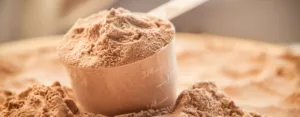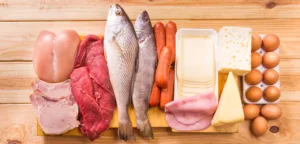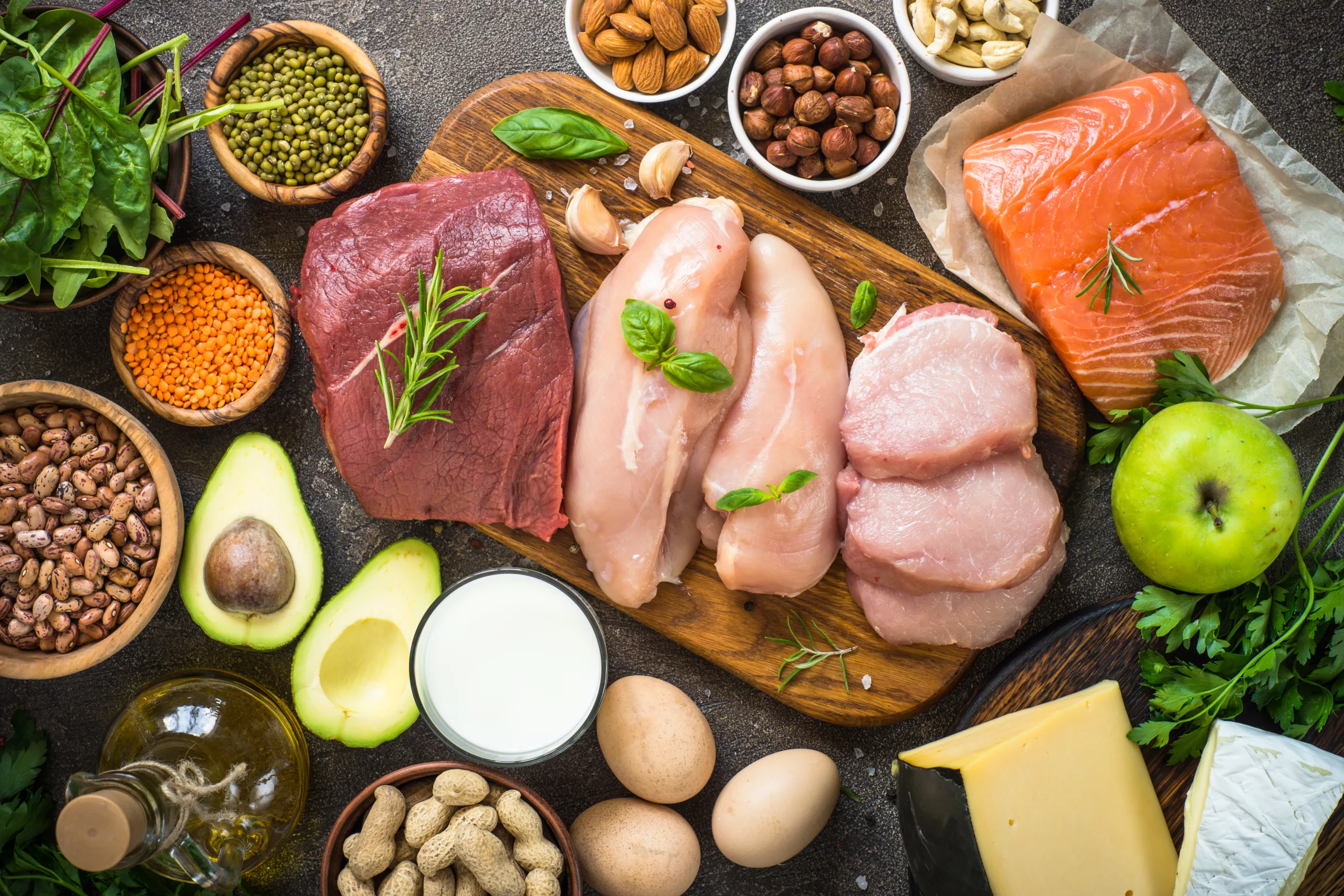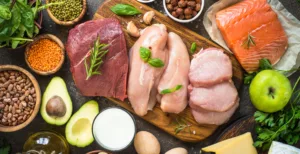How Much Protein Do Athletes Really Need?
Recommendations for both endurance and power athletes.
- Determining Protein Requirements
- Protein Requirements for Athletes
- Energy Restriction
- Protein Timing
- Main Takeaways
- About the Author
- References
- Comments
Determining Protein Requirements
Many of those reading this will be aware of the general recommendation of 1 gram (g) of protein per pound (lb) of body mass (24). However, it can be challenging to determine the specific protein requirements for athletes, as many factors can change the advised ranges.
Whether it is training status, individual sport, or dietary intake, many factors can influence recommendations for protein intake for athletes. Most data discussed in this article will deal with studies that used nitrogen balance to assess adequate protein requirements. From a physiological standpoint, to be in nitrogen (protein) balance means that protein (nitrogen) intake is equal to protein (nitrogen) loss (26).
While nitrogen balance is an accepted measure for assessing protein requirements, it has some drawbacks, which might result in recommendations that are too low (27). Along with nitrogen balance and protein quantity recommendations, it is also vital to keep a note of the quality of protein athletes are ingesting.
Protein Type and Quality
As many protein types exist, there is a range of protein quality and completeness that needs to be addressed when it comes to protein requirements (11).
Milk proteins (whey and casein) are typically rated as two of the highest qualities of proteins available while varying plant sources usually score the lowest (17). Protein sources from eggs, beef, poultry, fish, and dairy are regularly viewed as excellent sources of protein (11).
A protein source with all of the essential amino acids in the correct amounts and proportions to increase muscle protein synthesis is known as a complete protein (11). Incomplete proteins don’t contain at least one or more of the essential amino acids in the correct amounts or proportion (11).
Dietary protein sources of animal origin are broadly classified as complete protein sources, while sources of plant origin are commonly missing one or more of the essential amino acids and must be combined with complementary incomplete protein sources (11).
Protein Requirements for Athletes
Sedentary Adults
To first understand how much protein athletes need daily, the requirements of those that aren’t regularly active (sedentary) must first be understood. The current recommended dietary allowance (RDA) of protein is 0.8 g/ kilogram (kg) (0.36 g/ lb) body weight for sedentary adults (1).
However, a more recent analysis of the same data notes a value of 1.0 g/ kg (0.46 g/ lb) body weight for the average sedentary adult (12). Also, further analysis of daily requirements for sedentary adults using a more accurate amino acid analysis technique (Indicator Amino Acid Oxidation) found a value of 1.2 g/ kg (0.55 g/ lb) body weight for sedentary adults.
So overall, there exists a range in the literature when it comes to sedentary adults (0.8-1.2 g/ kg [0.36-0.55 g/ lb] body mass). This should be the absolute bare minimum that athletes ingest daily, but as athletes require more than the typical sedentary adult, read on to the next sections to determine individual needs based upon various situations.
Sedentary Adults: (0.8-1.2 g/ kg [0.36-0.55 g/ lb] body mass)
Endurance Athletes
When it comes to athletes, “cookie-cutter” recommendations aren’t the best ones to follow or consider. Endurance athletes are no different; protein requirements vary depending upon training status, exercise intensity, workout duration, and dietary intake (11). The best way to approach these variations is to classify athletes as recreational athletes (those predominantly performing low- to moderate-intensity endurance exercise), modestly trained athletes, and elite endurance athletes (31).
Multiple studies have found that a recreational level of endurance training does not alter the amount of protein needed for that athlete (31, 10). One such study by el-Khoury et al. (1997), found that a protein intake of 1.0 g/ kg (0.46 g/ lb) was adequate for recreationally active young men (10).
Recreational Endurance Athletes: (1.0 g/ kg [0.46 g/ lb] body mass)
For modestly trained athletes, multiple studies have reported protein intakes of 0.94 g/ kg, 0.86 g/ kg, and 1.0 g/ kg as being inadequate (16, 21, 12). These protein intakes resulted in net negative protein balances following exercise. Recommendations of 37.5 % higher than the RDA of protein (1.1 g/ kg [0.5 g/ lb]) are made following analysis of the three mentioned studies (31).
Modestly Trained Endurance Athletes: (1.1 g/ kg [0.5 g/ lb] body mass)
In terms of elite endurance athletes, a small collection of studies has examined their protein requirements. One found that 1.6 g/ kg (0.73 g/ lb) was needed in six elite male endurance athletes (29). Another advised that 1.46 g/ kg (0.66 g/ lb) was optimal for 5 elite endurance runners. A further study by Brouns et al. (1989) found a protein intake range of 1.5-1.8 g/ kg (0.68-0.82 g/ lb) was optimal within a Tour de France simulation (7).
If an endurance athlete is interested in improving their endurance exercise performance, diets high in protein appear to offer no benefit. Still, they may help reduce psychological stress and declines in performance commonly seen during blocks on high-intensity training (33).
Elite Endurance Athletes: (1.46-1.8 g/ kg [0.66-0.82 g/ lb] body mass)

Strength & Power Athletes
Acute resistance exercise increases rates of both muscle protein synthesis and muscle protein breakdown (5, 22). And ingestion of protein following resistance exercise is required for a positive protein balance (10). Regular resistance exercise along with adequate protein ingestion results in a positive protein balance which then leads to increases in lean body mass, something that strength/power athletes often prioritise (29).
Regular resistance exercise is also a source of stress and trauma that requires greater protein availability to recover (30). This theoretical framework suggests that strength/power athletes would have an increased requirement of dietary protein when compared to the needs of sedentary individuals (29, 13, 30).
A meta-analysis involving 680 participants across 22 published studies has also demonstrated a positive impact of protein supplementation on improvements in fat-free mass and leg strength when compared to a placebo in both young and old populations (8).
As with endurance athletes, multiple factors impact protein balance and protein requirements for strength/power athletes; however, training history and training status appear to significantly impact the efficiency with which the body processes protein (22, 23).
An example of this is the near-universal finding of untrained or unaccustomed individuals needing increased amounts of dietary protein. But when resistance training becomes habitual (>4 days/ week for at least 2 months), the body processes protein more efficiently which has led some studies to report that more trained individuals have lesser protein requirements (1.4 g/ kg [0.64 g/ lb] (30, 31).
Novice Strength Athletes (0-6 months training): (1.4 g/ kg [0.64 g/ lb] body mass)
Tarnopolsky et al. (1992) analysed the protein requirements for American football and rugby players by comparing low (0.86 g/ kg [0.39 g/ lb]), moderate (1.4 g/ kg [0.64 g/ lb]), and high (2.4 g/kg [1.1 g/ lb] amounts of dietary protein intakes (30).
They concluded that the lowest intake compromised protein synthesis when compared to the moderate and high intakes and that while the moderate protein intake amounted to a neutral protein balance, they recommended one standard deviation above at 1.76 g/ kg [0.8 g/ lb]. Other studies have also suggested that protein intakes ranging from 1.4-1.7 g/ kg [0.64-0.77 g/ lb] may be required for strength/power athletes (13, 30).
American Football/Rugby Players: (1.4-1.76 g/ kg [0.64-0.8 g/ lb] body mass)
The International Society of Sports Nutrition (ISSN) has also published position statements on the protein requirements of athletes, and they note 1.4-2.0 g/ kg [0.64-0.91 g/ lb] for resistance-trained athletes (7). And a consensus statement from ACSM et al. (2009) recommended protein intakes ranging from 1.2-1.7 g/ kg [0.55-0.77 g/ lb] (1).
International Consensus Statements: (1.2-2.0 g/ kg [0.55-0.91 g/ lb] body mass)
A fascinating and recent study was a systematic review, meta-analysis, and meta-regression by Morton et al. (2018) on the effects of protein supplementation on resistance training adaptations (19). Data from the review, including 49 previous studies and 1863 participants, showed that protein supplementation significantly improved fat-free mass gains, maximal strength, muscle fibre diameter, and cross-sectional area of femur thigh mass (19). The authors also noted that a protein intake higher than 1.62 g/ kg [0.74 g/ lb] showed no further improvements in fat-free mass gain.
Two other studies by Antonio et al. (2014, 2015) explored the impact of high-protein diets (at a caloric surplus) on body mass and composition (2, 3). Their first intervention had 30 resistance-trained individuals continue following their typical exercise training program alongside either a control or high-protein diet (4.4g/kg [2g/lb]) (2). While the 30 participants were at a caloric surplus for 8 weeks, no changes in body mass, fat mass, fat-free mass, or per cent body fat were found when compared to the control group.
Their follow-up intervention one year later dealt with 48 resistance-trained men and women and had them follow a prescribed split-body, 5 days/week resistance training program for 8 weeks (3). The participants followed either their normal diet of 2.3g/kg [1.05g/lb] of protein or a high-protein diet of 3.4g/kg [1.55g/lb]. Ultimately, the researchers found similar changes in strength, and the control group saw a significant increase in body mass.
In contrast, the high-protein group saw a greater decrease in fat mass and per cent body fat (3). They theorised that those changes in fat-free mass they saw in both of the groups were the result of a different training stimulus. They call back to their previous 2014 intervention and note that merely increasing protein intake to over 4g/kg [1.82g/lb] did not see equal increases in fat-free mass as their 2015 intervention which included resistance training.
Intermediate Strength Athletes (6 months – 2 years training): (1.62-1.76g/kg [0.64-0.8g/lb] body mass)
Energy Restriction
While increased protein intake is often seen as beneficial when wanting to gain mass, when an athlete’s goal is to decrease body mass, increased protein intake is even more critical. And what is also important to consider is the speed at which an athlete loses body mass. To read the Research Review on making weight the wrong way, click here.
Within another study dealing with changes in performance and body composition following a 2-week diet with a 40 % reduction in caloric intake, 20 healthy male athletes ingested either 1.0 g/ kg [0.45 g/ lb] or 2.3 g/ kg [1.05 g/ lb] of protein (17). They found that the higher protein diet lost significantly less fat-free mass, and both groups lost similar amounts of fat mass and performed similarly in all physical tasks assessed.
Pasiakos et al. (2010) also compared two diets differing in protein intakes alongside a steady-state endurance exercise programme (20). Under a 40 % reduction from pre-intervention caloric intake, the participants were split into diet groups ingesting either 0.8 g/ kg [0.36 g/ lb], 1.6 g/ kg [0.73 g/ lb], or 2.4 g/ kg [1.1 g/ lb] of protein. Following the 21-week intervention, the two groups that consumed higher amounts of protein (1.6 g/ kg [0.73 g/ lb] and 2.4 g/kg [1.1 g/ lb]) lost significantly less body mass, with a large majority being fat mass (65 %-70 %), and lost less fat-free mass when compared to the lowest protein group.
Lastly, a more recent study conducted by Longland et al., (2016) had participants ingest either 1.2 g/ kg [0.55 g/ lb] or 2.4 g/ kg [1.1 g/ lb] alongside an intense 6 days/ week exercise programme (15). Following 8 weeks, those in the higher protein group were able to gain more fat-free mass and lose fat mass simultaneously (often called body recomposition).
Athletes Seeking Weight Loss: (1.6-2.4 g/ kg [0.73-1.15 g/ lb] body mass)

Protein Timing
Now that daily protein requirements across many studies have been thoroughly analysed and noted, what is next important is protein intake on a per-meal basis as well as timing around training. Something else that shouldn’t be forgotten is daily protein quality as it relates to the quality of protein eaten within each meal.
The most common strategy involves consuming protein in and around a training session to repair muscular damage and enhance post-exercise strength and hypertrophy-related adaptations (28). It’s generally accepted that athletes should consume protein before and/or following training to take advantage of a well-known “anabolic window” (14). Though evidence-based support for a “narrow” window is far from definitive, its general acceptance often comes with the notion that training is undertaken in a fasted state (4).
Furthermore, pre-training nutrition may function as both a pre- and immediate post-exercise meal as digestion can persist well into the recovery period following exercise (28).
The effects of protein timing for increasing muscle protein synthesis related to exercise is a hotly debated subject in the literature. Borsheim et al., (2002), for example, found a dose of 6 g of essential amino acids (EAA) ingested immediately after exercise produced a twofold increase in protein balance (6). They also found that increasing the dose past 6 g didn’t significantly increase muscle protein synthesis.
Tipton et al. (2007), however, found that a 20g scoop of whey protein ingested pre-exercise elevated muscular uptake of EAAs to 4.4 x pre-exercise resting levels during exercise, and didn’t return to baseline levels until 3 hours post-exercise (32). Their finding points back to Aragon & Schoenfeld’s (2013), ideas around the effects of pre-exercise nutrition persisting well past an exercise session (4). As well as their notion of the next scheduled protein-rich meal (whether it occurs immediately or 1-2 hours post-exercise) is likely sufficient for maximising recovery and anabolism (4).
Lastly, within a meta-analysis of 20 studies and 478 participants by Schoenfeld et al. (2013), there was insufficient evidence to support a claim of a “narrow” (one-hour) anabolic window both before and after resistance exercise (28). They note that if an anabolic window does exist, it would appear to be greater than the currently held allotment of one hour. They go on further to state that any positive effects they saw within the studies they analysed were most likely due to overall daily protein intake and not the timing of protein intake (28).

Main Takeaways
- Many factors such as training status, individual sport, exercise intensity, exercise duration, or dietary intake can influence recommendations for protein intake for athletes
- Milk proteins are typically rated as the highest qualities of proteins available
- Protein sources from egg, beef, poultry, fish, and dairy are regularly viewed as excellent sources of protein
- Current RDA of protein is 0.8 g/ kg (0.36 g/ lb) body weight for sedentary adults
- Endurance athletes may ingest protein at a range of 1.0-1.8 g/ kg [0.46-0.82 g/ lb]
- Strength/Power athletes may ingest protein at a range of 1.4-2.0 g [0.64-0.91 g/ lb]
- Athletes currently in a weight-loss period may ingest protein at a range of 1.6-2.4 g/ kg [0.73-1.15 g/ lb]
- The evidence to support a narrow anabolic window is unsubstantial, and the most current literature on the subject point to a wider window of opportunity
References
- American College of Sports Medicine, American Dietetic Association, and Dietitians of Canada. (2009). Nutrition and Athletic Performance. Medicine & Science in Sports & Exercise, 41(3), 709–731. https://doi.org/10.1249/MSS.0b013e31890eb86
- Antonio, J., Peacock, C. A., Ellerbroek, A., Fromhoff, B., & Silver, T. (2014). The effects of consuming a high protein diet (4.4 g/kg/d) on body composition in resistance-trained individuals. Journal of the International Society of Sports Nutrition, 11(1), 19. https://doi.org/10.1186/1550-2783-11-19
- Antonio, J., Ellerbroek, A., Silver, T., Orris, S., Scheiner, M., Gonzalez, A., & Peacock, C. A. (2015). A high protein diet (3.4 g/kg/d) combined with a heavy resistance training program improves body composition in healthy trained men and women – a follow-up investigation. Journal of the International Society of Sports Nutrition, 12(1), 39. https://doi.org/10.1186/s12970-015-0100-0
- Aragon, A. A., & Schoenfeld, B. J. (2013). Nutrient timing revisited: Is there a post-exercise anabolic window? Journal of the International Society of Sports Nutrition, 10(1), 5. https://doi.org/10.1186/1550-2783-10-5
- Biolo, G., Maggi, S. P., Williams, B. D., Tipton, K. D., & Wolfe, R. R. (1995). Increased rates of muscle protein turnover and amino acid transport after resistance exercise in humans. American Journal of Physiology-Endocrinology and Metabolism, 268(3), E514–E520. https://doi.org/10.1152/ajpendo.1995.268.3.E514
- Børsheim, E., Tipton, K. D., Wolf, S. E., & Wolfe, R. R. (2002). Essential amino acids and muscle protein recovery from resistance exercise. American Journal of Physiology-Endocrinology and Metabolism, 283(4), E648–E657. https://doi.org/10.1152/ajpendo.00466.2001
- Brouns, F., Saris, W., H., Stroecken, J., Beckers, E., Thijssen, R., Rehrer, N., J., & ten Hoor, F. (1989). Eating, drinking, and cycling. A controlled Tour de France simulation study, Part II. Effect of diet manipulation. International Journal of Sports Medicine, 10(Suppl. 1):S41–8.
- Cermak, N. M., Res, P. T., de Groot, L. C., Saris, W. H., & van Loon, L. J. (2012). Protein supplementation augments the adaptive response of skeletal muscle to resistance-type exercise training: A meta-analysis. The American Journal of Clinical Nutrition, 96(6), 1454–1464. https://doi.org/10.3945/ajcn.112.037556
- Elango, R., Humayun, M. A., Ball, R. O., & Pencharz, P. B. (2010). Evidence that protein requirements have been significantly underestimated. Current Opinion in Clinical Nutrition and Metabolic Care, 13(1), 52–57. https://doi.org/10.1097/MCO.0b013e328332f9b7
- el-Khoury, A. E., Forslund, A., Olsson, R., Branth, S., Sjodin, A., Andersson, A., Atkinson, A., Selvaraj, A., Hambraeus, L., & Young, V. R. (1997). Moderate exercise at energy balance does not affect 24-h leucine oxidation or nitrogen retention in healthy men. American Journal of Physiology-Endocrinology and Metabolism, 273(2), E394–E407. https://doi.org/10.1152/ajpendo.1997.273.2.E394
- Kerksick, C. M. (2019). Chapter 38—Requirements of Proteins, Carbohydrates, and Fats for Athletes. In D. Bagchi, S. Nair, & C. K. Sen (Eds.), Nutrition and Enhanced Sports Performance (Second Edition) (pp. 443–459). Academic Press. https://doi.org/10.1016/B978-0-12-813922-6.00038-2
- Lamont, L. S., Patel, D. G., & Kalhan, S. C. (1990). Leucine kinetics in endurance-trained humans. Journal of Applied Physiology, 69(1), 1–6. https://doi.org/10.1152/jappl.1990.69.1.1
- Lemon, P. W., Tarnopolsky, M. A., MacDougall, J. D., & Atkinson, S. A. (1992). Protein requirements and muscle mass/strength changes during intensive training in novice bodybuilders. Journal of Applied Physiology, 73(2), 767–775. https://doi.org/10.1152/jappl.1992.73.2.767
- Lemon, P. W., Berardi, J. M., & Noreen, E. E. (2002). The role of protein and amino acid supplements in the athlete’s diet: does type or timing of ingestion matter?. Current sports medicine reports, 1(4), 214-221. https://doi.org/10.1007/s11932-002-0024-8
- Longland, T. M., Oikawa, S. Y., Mitchell, C. J., Devries, M. C., & Phillips, S. M. (2016). Higher compared with lower dietary protein during an energy deficit combined with intense exercise promotes greater lean mass gain and fat mass loss: A randomized trial. The American Journal of Clinical Nutrition, 103(3), 738–746. https://doi.org/10.3945/ajcn.115.119339
- Meredith, C. N., Zackin, M. J., Frontera, W. R., & Evans, W. J. (1989). Dietary protein requirements and body protein metabolism in endurance-trained men. Journal of Applied Physiology, 66(6), 2850–2856. https://doi.org/10.1152/jappl.1989.66.6.2850
- Mettler, S., Mitchell, N., & Tipton, K. D. (2010). Increased Protein Intake Reduces Lean Body Mass Loss during Weight Loss in Athletes. Medicine & Science in Sports & Exercise, 42(2), 326–337. https://doi.org/10.1249/MSS.0b013e3181b2ef8e
- Miller, S. L., Tipton, K. D., Chinkes, D. L., Wolf, S. E., & Wolfe, R. R. (2003). Independent and Combined Effects of Amino Acids and Glucose after Resistance Exercise. Medicine & Science in Sports & Exercise, 35(3), 449–455. https://doi.org/10.1249/01.MSS.0000053910.63105.45
- Morton, R. W., Murphy, K. T., McKellar, S. R., Schoenfeld, B. J., Henselmans, M., Helms, E., Aragon, A. A., Devries, M. C., Banfield, L., Krieger, J. W., & Phillips, S. M. (2018). A systematic review, meta-analysis and meta-regression of the effect of protein supplementation on resistance training-induced gains in muscle mass and strength in healthy adults. British Journal of Sports Medicine, 52(6), 376–384. https://doi.org/10.1136/bjsports-2017-097608
- Pasiakos, S. M., Cao, J. J., Margolis, L. M., Sauter, E. R., Whigham, L. D., McClung, J. P., Rood, J. C., Carbone, J. W., Combs, G. F., & Young, A. J. (2013). Effects of high-protein diets on fat-free mass and muscle protein synthesis following weight loss: A randomized controlled trial. The FASEB Journal, 27(9), 3837–3847. https://doi.org/10.1096/fj.13-230227
- Phillips, S. M., Atkinson, S. A., Tarnopolsky, M. A., & MacDougall, J. D. (1993). Gender differences in leucine kinetics and nitrogen balance in endurance athletes. Journal of Applied Physiology, 75(5), 2134–2141. https://doi.org/10.1152/jappl.1993.75.5.2134
- Phillips, S. M., Tipton, K. D., Aarsland, A., Wolf, S. E., & Wolfe, R. R. (1997). Mixed muscle protein synthesis and breakdown after resistance exercise in humans. American Journal of Physiology-Endocrinology and Metabolism, 273(1), E99–E107. https://doi.org/10.1152/ajpendo.1997.273.1.E99
- Phillips, S. M., Parise, G., Roy, B. D., Tipton, K. D., Wolfe, R. R., & Tarnopolsky, M. A. (2002). Resistance-training-induced adaptations in skeletal muscle protein turnover in the fed state. Canadian Journal of Physiology and Pharmacology, 80(11), 1045–1053. https://doi.org/10.1139/y02-134
- Phillips, S. M. (2004). Protein requirements and supplementation in strength sports. Nutrition, 20(7), 689–695. https://doi.org/10.1016/j.nut.2004.04.009
- Phillips, S. M., Tang, J. E., & Moore, D. R. (2009). The Role of Milk- and Soy-Based Protein in Support of Muscle Protein Synthesis and Muscle Protein Accretion in Young and Elderly Persons. Journal of the American College of Nutrition, 28(4), 343–354. https://doi.org/10.1080/07315724.2009.10718096
- Phillips, S. M., & Loon, L. J. C. V. (2011). Dietary protein for athletes: From requirements to optimum adaptation. Journal of Sports Sciences, 29(sup1), S29–S38. https://doi.org/10.1080/02640414.2011.619204
- Poortmans, J. R., Carpentier, A., Pereira-Lancha, L. O., & Lancha, A. (2012). Protein turnover, amino acid requirements and recommendations for athletes and active populations. Brazilian Journal of Medical and Biological Research, 45(10), 875–890. https://doi.org/10.1590/S0100-879X2012007500096
- Schoenfeld, B. J., Aragon, A. A., & Krieger, J. W. (2013). The effect of protein timing on muscle strength and hypertrophy: A meta-analysis. Journal of the International Society of Sports Nutrition, 10(1), 53. https://doi.org/10.1186/1550-2783-10-53
- Tarnopolsky, M. A., MacDougall, J. D., & Atkinson, S. A. (1988). Influence of protein intake and training status on nitrogen balance and lean body mass. Journal of Applied Physiology, 64(1), 187–193. https://doi.org/10.1152/jappl.1988.64.1.187
- Tarnopolsky, M. A., Atkinson, S. A., MacDougall, J. D., Chesley, A., Phillips, S., & Schwarcz, H. P. (1992). Evaluation of protein requirements for trained strength athletes. Journal of Applied Physiology, 73(5), 1986–1995. https://doi.org/10.1152/jappl.1992.73.5.1986
- Tarnopolsky, M. (2004). Protein requirements for endurance athletes. Nutrition, 7–8(20), 662–668. https://doi.org/10.1016/j.nut.2004.04.008
- Tipton, K. D., Elliott, T. A., Cree, M. G., Aarsland, A. A., Sanford, A. P., & Wolfe, R. R. (2007). Stimulation of net muscle protein synthesis by whey protein ingestion before and after exercise. American Journal of Physiology-Endocrinology and Metabolism, 292(1), E71–E76. https://doi.org/10.1152/ajpendo.00166.2006
- Witard, O. C., Jackman, S. R., Kies, A. K., Jeukendrup, A. E., & Tipton, K. D. (2011). Effect of Increased Dietary Protein on Tolerance to Intensified Training. Medicine & Science in Sports & Exercise, 43(4), 598–607. https://doi.org/10.1249/MSS.0b013e3181f684c9





